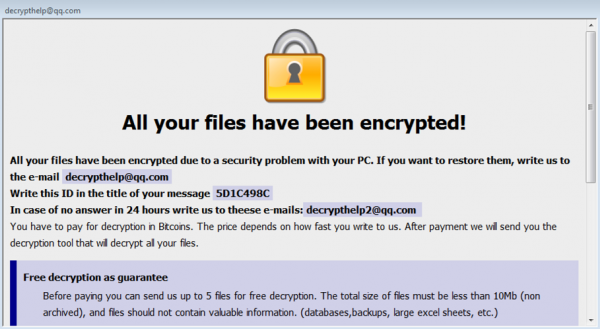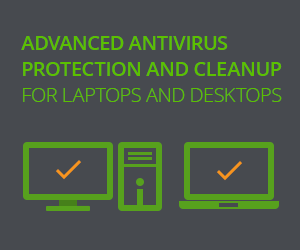[email protected] ransom Trojan is one of the strains for .java ransomware. Digging a bit further reveals the .java ransomware itself is but a spin-off, a new member of Drahma/Crysis encryption-for-ransom family.

Apart from [email protected], there are, at least, such instances of .java Trojan as 1777783646@@qq.com, [email protected].
One may wonder where all those weird names come from. They originate from renaming the files hit by the malicious encryption. For instance, a file called 1.png would be renamed, in the case of [email protected] attack, according to one of the following patterns:
1.png.id-[[email protected]].java
1.png.[[email protected]].java
Accordingly, other instances of java may rename the 1.png files as follows:
1.png.[ [email protected]].java
Meanwhile, other members of Java family, for instance, Crysis, would modify 1.png into something like 1.png. [email protected].
The [email protected] is an actual email. In addition to being included in the extra extension added to the original names of the files by Java ransomware, the email appears in its ransom note. Once the infection completes its encryption, this usually shows up automatically.
The encryption, obviously enough, follows the malware introduction. To get introduced, the crooks behind the virus deploy large-scale spamming campaigns. The deadly load lurks in the attachment the recipient is supposed to open. Moreover, the opening does not necessarily suffice. One may also need to activate a macro by accepting a relevant prompt request.
Prior to the encryption itself, [email protected] scans a computer system. The scanning is exclusive. It discards certain types of files and folders. They must not be encrypted. Otherwise, the system collapses or Internet connection fails. The crooks do not want this to happen. They need this basic functionality so that their victims would read the ransom note and contact them as instructed.
The decryption itself leverages a mix of military-grade algorithms. In theory, they are capable of withstanding any reverse-engineering and other direct computations with any power available to us so far. However, their implementation might have some flaws. IT researchers are making their best to spot and exploit any vulnerability to enable ultimate decryption.
The initial notification by the ransomware instructs the reader to proceed with contacting the crooks by email. In the case of the .java edition in question, this is the [email protected]. The response will be e demand for a ransom payable in bitcoins. The sum may reach and even exceed 1 BTC, which is likely to be above USD 10,000.
The sum is quite essential, yet does not ensure decryption. To get rid of [email protected] ransomware and remove the .java encryption, follow the guidance below.
Automatic removal of [email protected] Virus
The benefits of using the automatic security suite to get rid of this infection are obvious: it scans the entire system and detects all potential fragments of the virus, so you are a few mouse clicks away from a complete fix.
- Download and install recommended malware security suite
- Select Start Computer Scan feature and wait until the utility comes up with the scan report. Proceed by clicking on the Fix Threats button, which will trigger a thorough removal process to address all the malware issues compromising your computer and your privacy.
Restore files locked by [email protected] Virus
new Locky variant aka [email protected] Virus represents a unique category of malicious software whose attack surface reaches beyond the operating system and its components, which is why removing the virus itself is a part of the fix only. As it has been mentioned, it encrypts one’s personal information, so the next phase of the overall remediation presupposes reinstating the files that will otherwise remain inaccessible.
-
Launch data recovery software
Similarly to the rest of its fellow-infections, [email protected] Virus most likely follows an operational algorithm where it erases the original versions of the victim’s files and actually encrypts their copies. This peculiarity might make your day, because forensics-focused applications like Data Recovery Pro are capable of restoring the information that has been removed. As the virus further evolves, its modus operandi may be altered – in the meanwhile, go ahead and try this.
-
Take advantage of Volume Shadow Copy Service
This technique is based on using the native backup functionality that’s shipped with Windows operating system. Also referred to as Volume Snapshot Service (VSS), this feature makes regular backups of the user’s files and keeps their most recent versions as long as System Restore is on. [email protected] Virus ransomware hasn’t been found to affect these copies therefore the restoration vector in question is strongly recommended. The two sub-sections below highlight the automatic and manual workflow.
- a) Use Shadow Explorer
Shadow Explorer is an applet that provides an easy way of retrieving previous versions of files and folders. Its pro’s include an intuitive interface where the computer’s entire file hierarchy is displayed within one window. Just pick the hard disk volume, select the object or directory to be restored, right-click on it and choose Export. Follow the app’s prompts to get the job done.

- b) Use file properties
Essentially, what the above-mentioned Shadow Explorer tool does is it automates the process that can otherwise be performed manually via the Properties dialog for individual files. This particular approach is more cumbrous but just as effective as its software-based counterpart, so you can proceed by right-clicking on a specific file, which has been encrypted by [email protected] Virus, and selecting Properties in the context menu. The tab named Previous Versions is the next thing to click – it displays available versions of the file by date of the snapshot creation. Pick the latest copy and complete the retrieval by following the prompts.

-
Data backups work wonders
Ransomware like [email protected] Virus isn’t nearly as almighty and destructive in case you run regular file backups to the cloud or external data media. The virus itself can be completely removed in a matter of minutes, and the distorted information can then be just as easily recovered from the backup. Luckily, this is a growing trend, so ransom Trojans are hopefully going to become less subversive in the near future.
Verify thoroughness of the removal
Having carried out the instructions above, add a finishing touch to the security procedure by running an additional computer scan to check for residual malware activity
